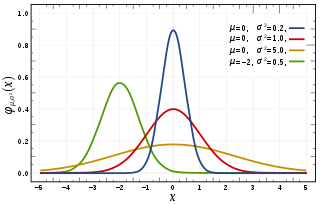In statistics, Hartley's test, also known as the Fmax test or Hartley's Fmax, is used in the analysis of variance to verify that different groups have a similar variance, an assumption needed for other statistical tests. It was developed by H. O. Hartley, who published it in 1950. [1]

Statistics is a branch of mathematics dealing with data collection, organization, analysis, interpretation and presentation. In applying statistics to, for example, a scientific, industrial, or social problem, it is conventional to begin with a statistical population or a statistical model process to be studied. Populations can be diverse topics such as "all people living in a country" or "every atom composing a crystal". Statistics deals with every aspect of data, including the planning of data collection in terms of the design of surveys and experiments. See glossary of probability and statistics.
Analysis of variance (ANOVA) is a collection of statistical models and their associated estimation procedures used to analyze the differences among group means in a sample. ANOVA was developed by statistician and evolutionary biologist Ronald Fisher. In the ANOVA setting, the observed variance in a particular variable is partitioned into components attributable to different sources of variation. In its simplest form, ANOVA provides a statistical test of whether the population means of several groups are equal, and therefore generalizes the t-test to more than two groups. ANOVA is useful for comparing (testing) three or more group means for statistical significance. It is conceptually similar to multiple two-sample t-tests, but is more conservative, resulting in fewer type I errors, and is therefore suited to a wide range of practical problems.

In probability theory and statistics, variance is the expectation of the squared deviation of a random variable from its mean. Informally, it measures how far a set of (random) numbers are spread out from their average value. Variance has a central role in statistics, where some ideas that use it include descriptive statistics, statistical inference, hypothesis testing, goodness of fit, and Monte Carlo sampling. Variance is an important tool in the sciences, where statistical analysis of data is common. The variance is the square of the standard deviation, the second central moment of a distribution, and the covariance of the random variable with itself, and it is often represented by , , or .
Contents
The test involves computing the ratio of the largest group variance, max(sj2) to the smallest group variance, min(sj2). The resulting ratio, Fmax, is then compared to a critical value from a table of the sampling distribution of Fmax. [2] [3] If the computed ratio is less than the critical value, the groups are assumed to have similar or equal variances.

In mathematics, a ratio is a relationship between two numbers indicating how many times the first number contains the second. For example, if a bowl of fruit contains eight oranges and six lemons, then the ratio of oranges to lemons is eight to six. Similarly, the ratio of lemons to oranges is 6:8 and the ratio of oranges to the total amount of fruit is 8:14.
In statistics, a sampling distribution or finite-sample distribution is the probability distribution of a given random-sample-based statistic. If an arbitrarily large number of samples, each involving multiple observations, were separately used in order to compute one value of a statistic for each sample, then the sampling distribution is the probability distribution of the values that the statistic takes on. In many contexts, only one sample is observed, but the sampling distribution can be found theoretically.
Hartley's test assumes that data for each group are normally distributed, and that each group has an equal number of members. This test, although convenient, is quite sensitive to violations of the normality assumption. [4] Alternatives to Hartley's test that are robust to violations of normality are O'Brien's procedure, [4] and the Brown–Forsythe test. [5]

In probability theory, the normaldistribution is a very common continuous probability distribution. Normal distributions are important in statistics and are often used in the natural and social sciences to represent real-valued random variables whose distributions are not known. A random variable with a Gaussian distribution is said to be normally distributed and is called a normal deviate.
The Brown–Forsythe test is a statistical test for the equality of group variances based on performing an ANOVA on a transformation of the response variable. When a one-way ANOVA is performed, samples are assumed to have been drawn from distributions with equal variance. If this assumption is not valid, the resulting F-test is invalid. The Brown–Forsythe test statistic is the F statistic resulting from an ordinary one-way analysis of variance on the absolute deviations of the groups or treatments data from their individual medians.


